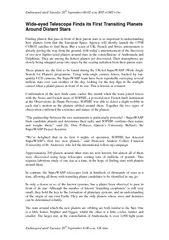PPT-Tuesday, October 17, 2017
Author : caroline | Published Date : 2023-10-04
Nanotechnology 1 Nanoscince and Nanotechnology The word nano is a Greek prefix meaning dwarf or something very small and depicts one billionth 10 9 of a unit
Presentation Embed Code
Download Presentation
Download Presentation The PPT/PDF document "Tuesday, October 17, 2017" is the property of its rightful owner. Permission is granted to download and print the materials on this website for personal, non-commercial use only, and to display it on your personal computer provided you do not modify the materials and that you retain all copyright notices contained in the materials. By downloading content from our website, you accept the terms of this agreement.
Tuesday, October 17, 2017: Transcript
Download Rules Of Document
"Tuesday, October 17, 2017"The content belongs to its owner. You may download and print it for personal use, without modification, and keep all copyright notices. By downloading, you agree to these terms.
Related Documents














